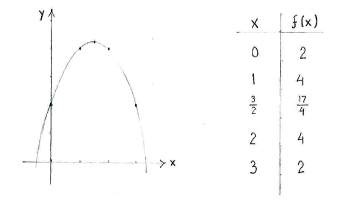Lösung 1.3:2b
Aus Online Mathematik Brückenkurs 2
(Unterschied zwischen Versionen)
| Zeile 2: | Zeile 2: | ||
# stationäre Punkte, wo <math>f^{\,\prime}(x)=0</math>, | # stationäre Punkte, wo <math>f^{\,\prime}(x)=0</math>, | ||
| - | # Singuläre Punkte, | + | # Singuläre Punkte, wo die Funktion nicht ableitbar ist, oder |
# Endpunkte. | # Endpunkte. | ||
Version vom 16:21, 26. Apr. 2009
Lokale Extrempunkte einer Funktion sind entweder:
- stationäre Punkte, wo \displaystyle f^{\,\prime}(x)=0,
- Singuläre Punkte, wo die Funktion nicht ableitbar ist, oder
- Endpunkte.
Wir untersuchen alle drei Fälle:
- Die Ableitung von \displaystyle f(x) ist
and becomes zero when \displaystyle x=3/2\,.\displaystyle f^{\,\prime}(x) = 3-2x - Nachdem die Funktion ein Polynom ist, ist sie überall ableitbar.
- Die Funktion ist überall definiert, und also hat unser Intervall keine Endpunkte.
Also sind alle lokalen Extrempunkte auch stationäre Punkte, und also ist \displaystyle x=3/2\, der einziger Punkt der ein Extrempunkt sein könnte. Wir untersuchen ob der Punkt ein Extrempunkt ist, mit einer Vorzeichentabelle.
| \displaystyle x | \displaystyle \tfrac{3}{2} | ||
| \displaystyle f^{\,\prime}(x) | \displaystyle + | \displaystyle 0 | \displaystyle - |
| \displaystyle f(x) | \displaystyle \nearrow | \displaystyle \tfrac{17}{4} | \displaystyle \searrow |
Nachdem die Funktion eine quadratische Funktion ist, ist deren Graph eine Parabel mit den Maxima \displaystyle (3/2, 17/4).

